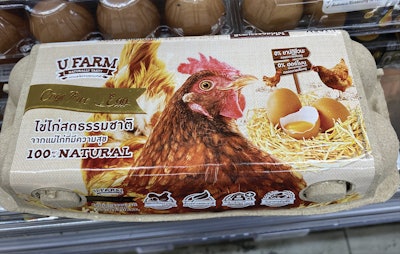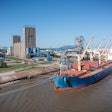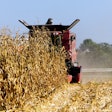
The center of growth in the global poultry industry – Asia – came under the spotlight at the International Poultry Forum China. The event organized by WATT Global Media and Lyja Media, held for the first time outside of China, took place as part of VIV Asia 2025, and examined changes across the continent from genetics through to consumption.

In Thailand, Malaysia, Vietnam, the Philippines and Indonesia, growth in white feather broiler production is forecast to be in the region of 3-3.5% this year. In contrast, while still positive, production in China is expected to be in the region of 2% in 2025, held back by strong inventories and competition from competitor proteins.
Growth is expected to remain strong to 2030, at some 3%. Vietnam is expected to return the strongest performance, possibly reaching 5%, while expansion may be slowest, around 1.5-2% in Malaysia. Overall, however, expansion will be strong over a sustained period.
Building on positive fundamentals
Asia has a positive outlook, however, the industry could do more to take full advantage of the strong demand that exists for broiler meat, and Sherrard noted that consumption is evolving more quickly than production, driven by convenience, food service and e-commerce.
The industry must evolve to take full advantage of this strong and changing demand, products must better align with these changing consumer tastes. This is particularly important in China and, perhaps, more so in Thailand and Malaysia. To a certain extent, it is also the case in Vietnam.
Sherrard emphasized that more time must be spent on understanding the consumer, and the need to move away from simply seeing growth as selling more tons of broiler meat and to concentrate on product value. Additionally, more attention needs to be paid to competition from competitor proteins. In China, for example, demand for pork is currently strong, to the detriment of the broiler industry.
The ongoing closure of wet markets will push producers to adapt their offerings. While their closure signifies the loss of a sales channel, it could act as a stimulus to offer these higher value products. It will be in the Philippines, Vietnam and Indonesia where this change will be particularly important.

Export opportunities
Export opportunities for the region’s producers are numerous, especially for China and Thailand, despite the challenges of an uncertain world.
The region’s exporters have had a couple of difficult years, but this is changing. Vietnam, for example should have plenty of opportunities to sell overseas, given its membership of the trade and economic integration initiative the Comprehensive and Progressive Agreement for Trans-Pacific Partnership (CPTPP). Where China is concerned, exports have performed well over recent years, and this is expected to continue.
However, exporters must realize that there is a growing trend within the market to self-sufficiency, barriers to trade resulting from disease will continue and the “America First” trade policy will increase volatility.
Possible ways of making the most of opportunities include building strong partnerships, sourcing feed and raw chicken from South America, and concentrating on trade in processed chicken.
Global and Asian markets are changing in a variety of ways and how these changes are playing out was continued by Gordon Butland, director, G&S Agriconsultants Co Ltd.
He noted that, while the global population is expected to increase, resulting in more mouths to feed, this increase will not occur evenly across the globe, with much occurring in Africa. Some regions will see their populations decline, and populations are aging globally. Where populations are declining or aging there will be an impact not only on consumption but also on finding labor.
Looking particularly at Thailand, he pointed to the country’s declining birthrate. Some forecasters believe that the Thai population could be half its current size within 60 years, while the working age population is expected to fall by 40% over the next 50 years.
The Thai poultry industry already relies heavily on foreign labor for much of its workforce. With birth rates falling across Asia, this change has clear implications for any industry that relies upon cheap and plentiful labor.
While an aging, older people eat less, and shrinking populations will pose challenges for the industry, other demographic changes are proving more positive. The Muslim population, for example, is increasing at a faster rate than the non-Muslim population, which will help to foster chicken consumption.
Butland then posed the question as to which is the cheapest meat in Asia, and the answer was not, perhaps, what many delegates were expecting. Within Asia, only in Thailand is chicken the most consumed meat. It is fish, not chicken, that is the number one protein in 10 out of 11 countries in Asia.
Focus on China
Like other Asian countries, China continues to quickly evolve, but perhaps unlike some of its neighbors, China is a particularly complex market.
Focusing on China, Professor Yang Ning, of the China Agricultural University, noted that the country has many different poultry breeds, a wide array of products and a broad range of production methods, and, importantly, it has the world’s largest poultry flock.
The country’s egg industry, the largest in the world, exemplifies that diversity. The market not only comprises brown and white eggs, but also pink or tinted eggs. These pink eggs, rather than declining in popularity due to mainstream egg production, have seen demand rise over the past two decades. Professor Ning explained that consumers favor these “very special eggs” as they remind them of eggs from traditional, native breeds.
China is predominantly a brown egg market, but there is some white and also some blue egg production.
Where production methods are concerned, 50 years ago almost all production was free range, but by the 1990s, almost all had converted to traditional cages. Some 10-20 years ago there was a further shift with producers adopting automatic tiered cages. This production method is used in almost all newly constructed layer houses and offers a very efficient way to produce eggs.
These tiered cages can be six to 10 tiers high, and up to 200,000 layers can be kept in a single house. These houses are not only efficient, but necessary in a country where land is scarce and permission to construct new layer houses is difficult to gain. They also require less labor – two laborers can easily manage 100,000 layers on a daily basis.
He noted that the house environment is very precisely controlled, with a high degree of automation. He also pointed to the use of inspection robots that can report, for example, a dead or sick bird, air quality, and temperature in real time.
For those that question the welfare of such systems, the professor argued that welfare is high and that 100% of broiler production could move to this approach.
Where broiler production is concerned, in addition to fast growing broilers, China also has its yellow-feather birds, primarily in the south of the country. These birds are seen as having a superior taste, but grow more slowly with poor feed efficiency, meaning that they sell at a higher price than white-feathered birds.
Chinese producers now also have access to what is called “small white broiler” – a cross between a fast-growing broiler and a traditional high yield layer. The country also makes full use of spent hens, seen as being a healthy and highly nutritious option.
Despite this variety, it is pork not chicken that remains the favorite meat in China. This, however, is changing, particularly among younger generations, opening up more opportunities for the industry.
Avian influenza
While parts of the world continue to debate vaccination against avian influenza (AI), various countries are already practicing it, for example, China, Vietnam, Indonesia, Bangladesh, Egypt, France and Mexico.
Offering a global view and outlook, Nicolò Cinotti, secretary general of the International Poultry Council (IPC) noted that the debate around whether to vaccinate is highly complex. A properly designed vaccination plan faces several challenges, he said, few of which are intrinsically linked to the vaccine itself.
The IPC’s position, he noted, is that vaccination could play a role as part of a broader strategy against AI, which would include biosecurity, flock health management and surveillance to control viral spread and contribute to controlling the virus in domestic poultry.
However, he continued, new tools and interventions, such as vaccines, must not have an adverse impact on the trade in genetic stock, hatching eggs, day old chicks, poultry meat and eggs, and their related products.
State of the art vaccine strategies for AI applied under veterinary authority control must allow for virus detection, as well as be able to differentiate vaccinated from infected birds.
He added that regions and countries should be encouraged to adopt, and mutually recognize, zoning and compartmentalization which support trade.
Additionally, there needs to be greater recognition that animal care, health, welfare and reducing animal protein waste are critical goals for poultry meat and egg producers globally, and contribute to sustainable global food security, which is part of global health security.


















